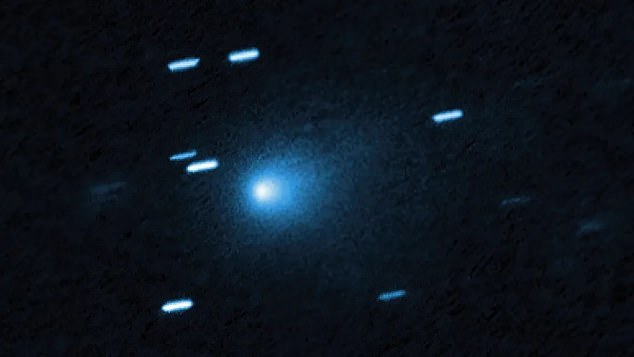An interstellar object speeding through our Solar System has been spotted spewing a metal unlike anything seen in natural comets.
The Very Large Telescope (VLT) in Chile detected an unusual nickel plume from the object, known as 3I/ATLAS. Unlike natural comets, which always emit nickel alongside iron, 3I/ATLAS shows the metallic element without any detectable iron.
Harvard physicist Avi Loeb highlighted the anomaly described in a new study, noting that this nickel signature is a hallmark of industrial production of nickel alloys.
‘Is this anomaly another clue for a possible technological origin of 3I/ATLAS?’ Loeb wrote in a blog post.
‘The paper suggests that chemical formation occurs through the nickel carbonyl channel, an extremely rare process in comets, but a standard technique in industrial nickel refining,’ he added.
The new study, published by astrophysicists in Chile on Wednesday, found that 3I/ATLAS is shedding nickel at roughly five grams per second and cyanide at 20 grams per second, with both rising sharply as the object moves closer to the sun.
Researchers noted that the mechanisms driving these emissions are not typical of natural cometary processes.
They hypothesized that nickel might be released from dust through gentle processes, such as sunlight, causing it to evaporate or breaking down small nickel-containing compounds.

A new study has revealed that the interstellar object 3I/ATLAS is releasing nickel without iron, an anomaly that a Harvard physicist said could hint at industrial or technological processes
Traditional comets are typically water-rich and release gases such as water, carbon monoxide and carbon dioxide as they approach the sun.
They also emit nickel and iron together, as both elements are produced in the same cosmic processes, like supernova explosions.
3I/ATLAS, however, deviates sharply from this pattern by releasing nickel without any detectable iron.
Additionally, both nickel and cyanide emissions rise steeply as it approaches the sun, unlike the more gradual outgassing seen in normal comets.
NASA also released new observations of 3I/ATLAS this week, taken by SPHEREx and the James Webb Space Telescope, showing that its gas plume is dominated by carbon dioxide and only five percent water.
This makes it unlike the vast majority of comets seen because most of its brightness comes from the cloud of dust around it, not its solid core.
‘These results add to the chemical anomalies implied by the SPHEREx space observatory and Webb space telescope [are] very different from an expected water-rich comet,’ Loeb shared in a blog post.
‘The idea that the nucleus is much smaller than the 29-mile diameter inferred from the 1-micron data collected by SPHEREx requires a dense coma of dust to reflect nearly all the sunlight from 3I/ATLAS.

NASA’s James Webb captured its first look at the interstellar object this month, showing it is not 12 miles in diameter as originally thought. It’s closer to 1.7 miles long
‘In that case, the dust would be pushed by solar radiation pressure to trail the nucleus, forming a prominent cometary tail.’
Loeb added that observations from NASA’s Hubble Space Telescope failed to identify a cometary tail.
Read More
EXCLUSIVE Chilling theory emerges about suspicious activity in space… as Harvard expert warns we will tear ourselves apart: ‘Time to worry’

The object was first identified in July 2025 by the ATLAS telescope network, which searches for objects that might hit Earth.
Earlier images taken by the Vera C Rubin Observatory in Chile had unknowingly photographed the object, but no one realized it was there at the time.
Until now, 3I/ATLAS has been a total mystery, as early scans suggested the object was larger than anything that had ever passed through the solar system, and might even be generating its own light.
These characteristics have led Loeb to suggest other possibilities, such that 3I/ATLAS is an artificial craft developed by an extraterrestrial civilization.
The idea has been dismissed by many scientists, including Chris Lintott, an astronomer at the University of Oxford, who said Loeb’s theory is ‘nonsense on stilts,’ calling it ‘an insult to the exciting work going on to understand this object.’
